See the previous 1.1 changelog.
See the next 1.3 changelog.
What's Changed?
With this iteration of the vacuum test bench, we added a new test to measure vacuum airflow and slightly updated our existing 'Suction' test. We've listed the changes made to our test methodology below.
| Test Group | Change |
| Airflow |
|
| Suction |
|
Here, we'll examine these new changes and how they can help you find the right vacuum for your needs. If you want to know more about our research and development process with this update—including investigations into the specifics of airflow measurement, the impact of airflow sensor placement, and how different vacuum types are expected to perform, you can check out our R&D article.
Airflow
Here's an example of what the new 'Airflow' test looks like in one of our reviews.
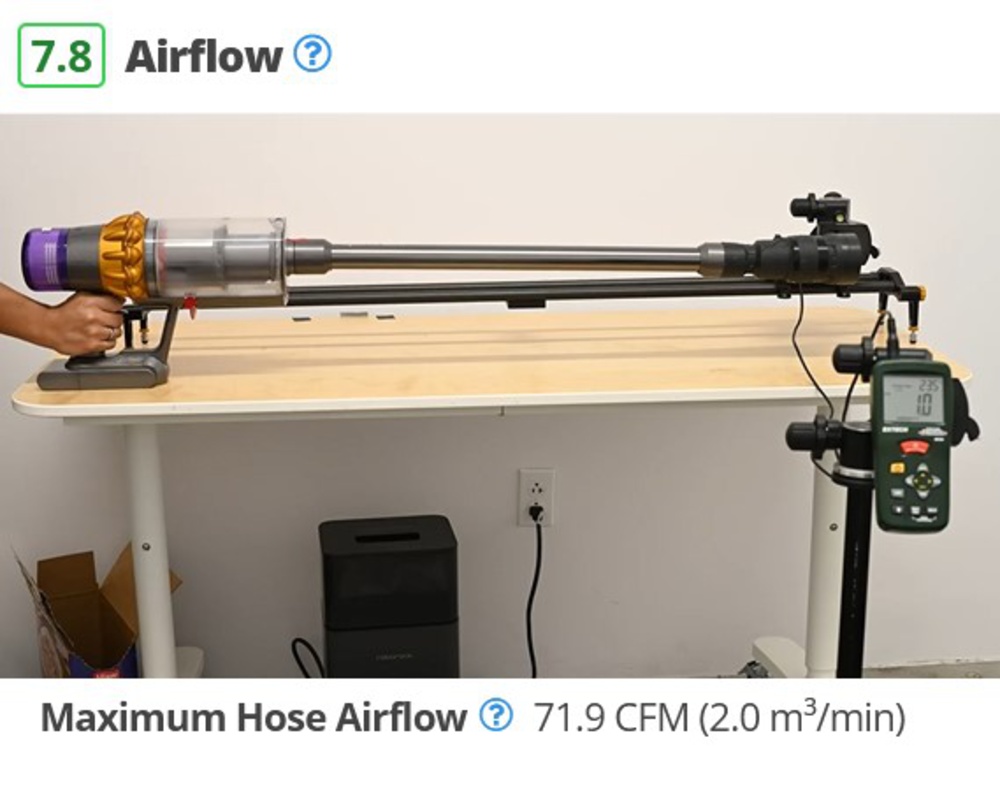 Dyson V15 Airflow Test
Dyson V15 Airflow Test
The new box comprises a single element:
- Maximum Hose Airflow
Ultimately, this new test is self-explanatory, as it measures how much air a vacuum can move in its most powerful setting, using a customized anemometer and funnel arrangement to create a tight seal against the vacuum. It's an important supplement to our testing methodology, as it helps provide a far more comprehensive overview of system performance compared to measuring suction alone. After all, a vacuum can deliver superb suction but mediocre airflow performance; a clear example of why testing both elements is so important can be seen with a handheld vacuum like the Shark WANDVAC. The narrow suction inlet of this kind of vacuum would fully seal with the testing rig, resulting in a very high reading from our manometer. However, the actual volume of air moving through the system is very low, so naturally, debris pickup falls far behind a full-sized model.
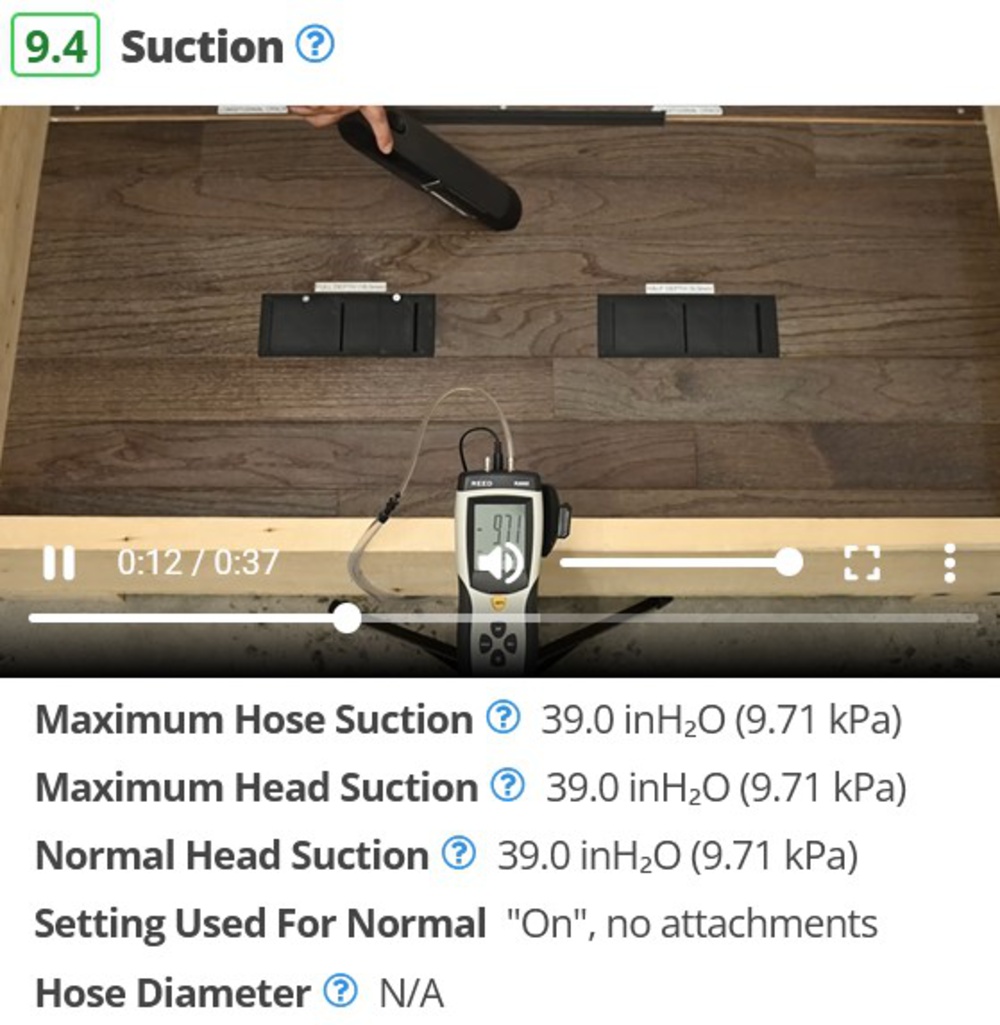 The 'Suction' test box for the Shark WANDVAC on Test Bench 1.2. Notice the high value for max suction.
The 'Suction' test box for the Shark WANDVAC on Test Bench 1.2. Notice the high value for max suction.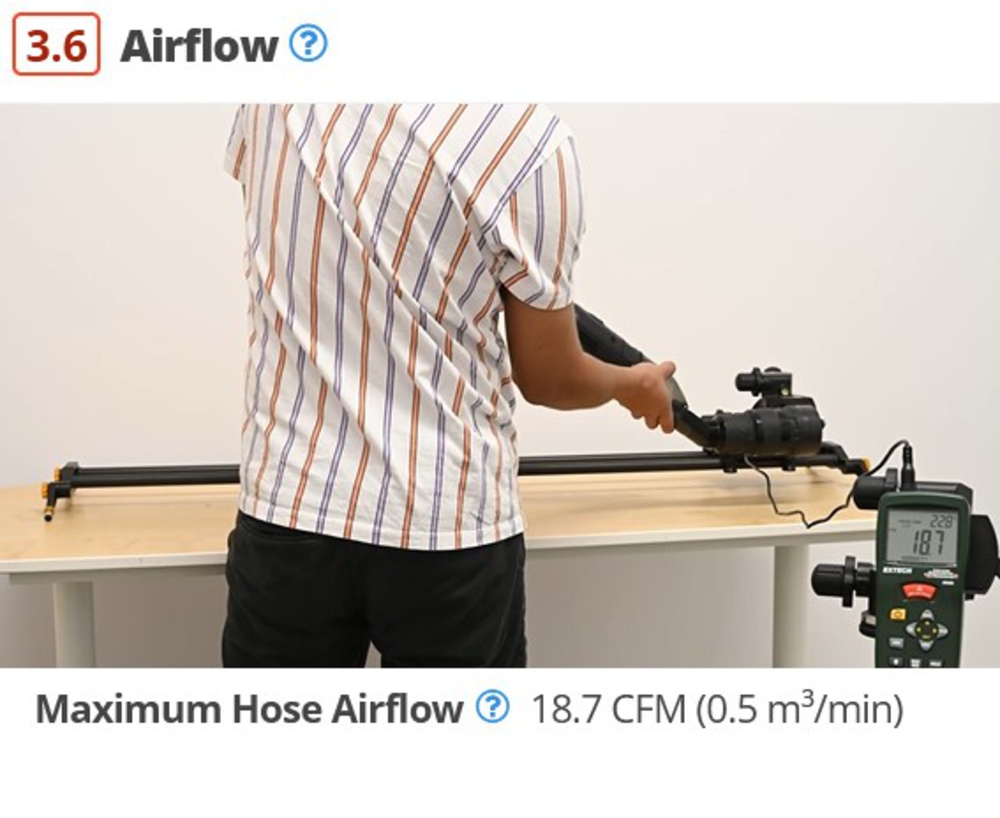 The 'Airflow' test box for the Shark WANDVAC on Test Bench 1.2. Adding the Airflow measurement gives a more complete picture of the overall vacuum's performance.
The 'Airflow' test box for the Shark WANDVAC on Test Bench 1.2. Adding the Airflow measurement gives a more complete picture of the overall vacuum's performance.It's worth noting that we test airflow differently for robot and non-robot vacuums. Since robovacs don't have a hose to measure from, they're set up on a different testing apparatus, being held aloft by foam padding, with an anemometer measuring airflow from their suction inlet. As such, the airflow measurements between robot and non-robot vacuums aren't directly comparable. If you'd like to read further into our reasoning and methodology for testing airflow differently on robot vacuums, refer to our R&D article.
Suction
We've also updated our suction test to evaluate suction measured directly from the hose, as opposed to only the floorhead. Measuring suction from the hose paints a clearer picture of a vacuum's raw suction power than from measuring from the vacuum head. However, this obviously isn't as applicable to real-world usage. Here's a clear comparison between our previous and current iterations of the 'Suction' test.
NEW
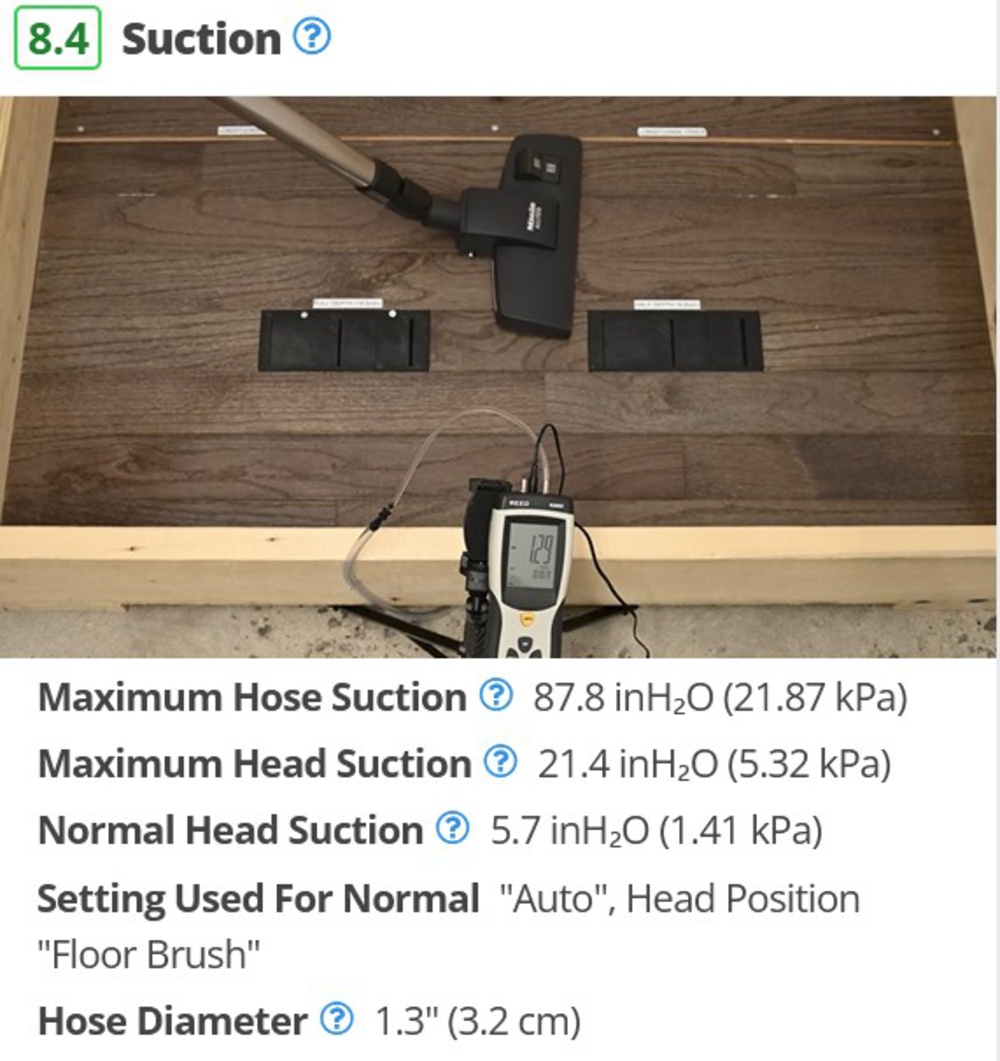 Suction measured for the Miele Complete C3 on Test Bench 1.2 - notice the new 'Maximum Hose Suction' field.
Suction measured for the Miele Complete C3 on Test Bench 1.2 - notice the new 'Maximum Hose Suction' field.Note that we've also renamed the ' Maximum Suction' test field to ' Maximum Head Suction' and the 'Normal Suction' test field to 'Normal Head Suction' to more clearly demonstrate where we're testing suction from.
Let Us Know What You Think
As always, our test methodology is a work in progress, and we depend on your feedback to improve it. Our methodology can always benefit from more meaningful tests. If you have comments, questions, or suggestions about this or any future updates, reach out to us in the forums.
69 Vacuums Updated
We have retested popular models. The test results for the following models have been converted to the new testing methodology. However, the text might be inconsistent with the new results.
- Airsign HEPA Vacuum
- BISSELL CleanView/CleanView Swivel Pet Rewind
- BISSELL CrossWave Cordless Max
- BISSELL CrossWave Pet Pro
- BISSELL Featherweight Stick
- BISSELL Pet Hair Eraser Turbo Plus [Turbo, Turbo Rewind]
- BISSELL PowerForce Helix
- Black+Decker 16V MAX dustbuster Cordless Hand Vacuum
- Black+Decker dustbuster AdvancedClean+ Pet
- Dirt Devil Endura Max
- Dyson Ball Animal 2 Total Clean/Origin
- Dyson Ball Animal 3 Extra
- Dyson Cyclone V10
- Dyson Gen5detect
- Dyson Gen5outsize
- Dyson Humdinger
- Dyson Outsize
- Dyson V11
- Dyson V12 Detect Slim
- Dyson V15 Detect
- Dyson V7
- Dyson V8
- Eureka Mighty Mite
- Eureka Whirlwind Bagless Canister
- Hoover ONEPWR Evolve Pet
- JASHEN V16
- Kenmore Intuition Bagged
- LG CordZero A9 [A916, A916BM]
- Miele Classic C1
- Miele Complete C3 Alize
- Miele Dynamic U1 PowerLine
- Miele Triflex HX1
- Milwaukee M18 FUEL 3-in-1 Backpack Vacuum Kit
- Roborock H7
- RYOBI 18V One+ 3 Gal. Project P3240
- Samsung Bespoke Jet
- Samsung Jet 60
- Samsung Jet 70
- Samsung Jet 75
- Samsung Jet 90 Complete
- SEBO Airbelt D4 Premium
- Shark APEX UpLight
- Shark APEX Upright
- Shark Cordless Pet IX141
- Shark Cordless Pet Plus IZ361H
- Shark Cordless Pro IZ562H
- Shark Navigator Lift-Away Deluxe [NV360, UV440]
- Shark Navigator Lift-Away Speed
- Shark Rocket Corded
- Shark Rocket Pet Pro
- Shark Rotator Lift-Away ADV
- Shark Rotator Powered Lift-Away [NV751, NV752]
- Shark Stratos Cordless IZ862H
- Shark Stratos UltraLight HZ3002
- Shark Stratos Upright AZ3002
- Shark UltraCyclone Pet Pro+ [CH951, CH964AMZ]
- Shark Vertex Lightweight Cordless [IZ440H, IZ462H, IZ483H]
- Shark Vertex Pro Lightweight [IZ662H, IZ682H]
- Shark Vertex Pro Powered Lift-Away ICZ362H
- Shark Vertex UltraLight Corded
- Shark WANDVAC
- Shark WANDVAC System [WS620, WS632, WS642]
- Tineco PURE ONE S11
- Tineco PURE ONE X
- Tineco PWRHERO 11
- Tineco S10
- Wyze Cordless Vacuum
- Wyze Handheld Vacuum
- Xiaomi Mi Vacuum Cleaner Light
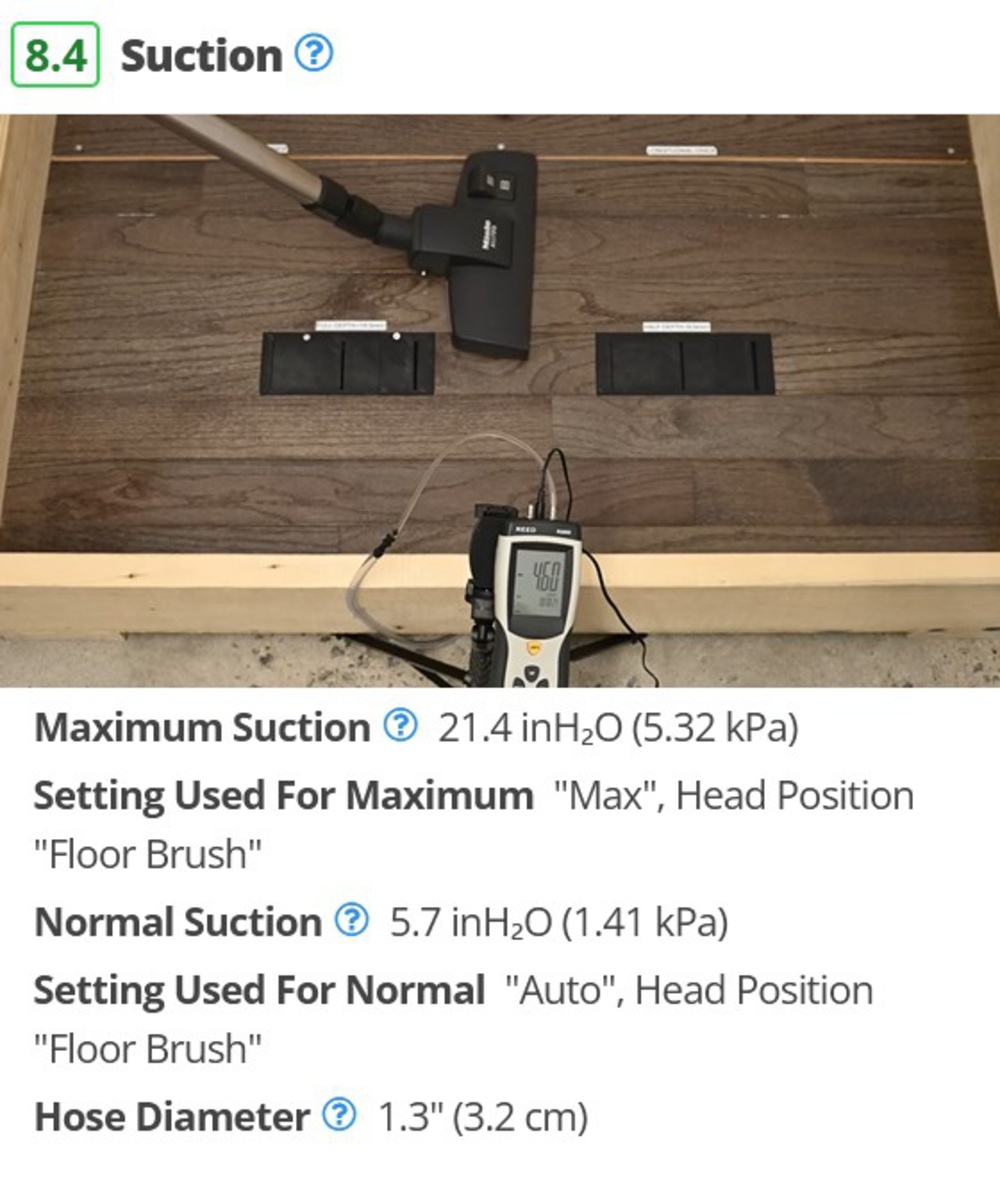 Suction measured for the Miele Complete C3 on Test Bench 1.1.
Suction measured for the Miele Complete C3 on Test Bench 1.1.